10th January 2016
Lieutenant F.G. (Frederick Guthrie) Tait was a leading golfer at the end of the 19th Century. A hugely charismatic man he starred alongside Johnny Ball, Harold Hilton, Harry Vardon and J.H. Taylor. At a time when amateurs and pros played together a lot their combined popularity helped to grow the game in Great Britain and Ireland.
So why haven’t most people heard of him ? Well sadly he only played competitive golf for 9 years before he was tragically killed aged 30 serving his country in the Second Boer War. Despite this his happy demeanour, good sportsmanship and attacking, winning play made him a national hero and left a golfing legacy that endures to this day.
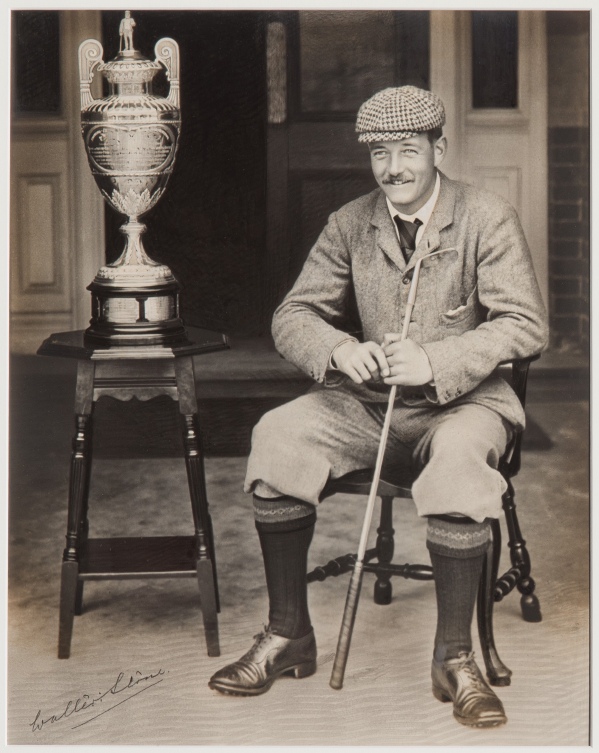
Freddie Tait with The Amateur Championship Trophy in 1898
So let’s take a look at the life of this important historical figure: –
1. Freddie Tait was born just under 150 years ago in Edinburgh, Scotland on 11th January 1870.
2. His father, Peter, was an Edinburgh University professor and fanatical golfer. As such the family spent most of their summer holidays in nearby St. Andrews. He started playing golf aged 5 and along with his three brothers learned to play the game on the Old Course. The family would often play up to five rounds a day starting at 6.00am. Professor Tait, known as ‘The Governor’ by Freddie, undertook many of the earliest experiments on the physics of golf using his son to produce the ball striking data he required.
3. After completing his education at the Edinburgh Academy he joined the Royal Military College at Sandhurst – where it is said he introduced golf – and became an infantry soldier, eventually serving with the 2nd Battalion of The Black Watch (Royal Highlanders). He clearly had some flexibility with his employment and when he was not guarding Queen Victoria during her Balmoral stays he appears to have been able to play golf at will, be it friendlies, competitive matches or tournaments.

4. He became a member of the Royal & Ancient G.C. of St. Andrews in early 1890 just after he had turned 20. Thereafter he repeatedly set new Old Course scoring records. A 77 in 1890, a 72 in 1894 and then in 1897 a remarkable 69. From an early age he kept detailed records of all his matches, detailing his scores and play as well as the course conditions and his opponent’s play.
5. He was a 6 foot tall powerful man and one of the longest hitters of his era. He became famous nationwide when on 11th January 1893 he produced a record breaking drive of 341 yards on the 13th hole of the Old Course. His gutta-percha ball flew 250 yards and ran a further 91 yards on the frozen fairway. This more than exceeded his Father’s “scientifically proven” maximum drive distance.
6. In total he won 28 tournaments between 1893 and 1899, many of them on the Old Course in Royal & Ancient Golf Club competitions. He also won three St. George’s Challenge Cups at Royal St. George’s. In his final 1899 season he won the Prestwick Silver Medal, the St. George’s, the three major Medals at the Royal & Ancient, the Calcutta Cup and was runner-up in the Amateur. In July 1899 he shot a new course record 63 at the old Archerfield Links. This was clearly a man at the top of his game come the turn of the century.
7. His greatest golfing achievements were his two Amateur Championship victories. Having reached the semi-finals in 1893, 1894 and 1895 his first victory came in 1896 when he beat Harold Hilton 8&7 in the final at Royal St. George’s. This was the first year the final was played over 36 holes and Tait went into the Championship as favourite having won the stroke play St. George’s Challenge Cup played immediately before it. Nevertheless his first win was hard fought; the draw seeing him have to beat John Laidlay, John Ball and Horace Hutchinson, all previous multiple Amateur champions, before facing Hilton.

Freddie Tait tees off against Harold Hilton in The Amateur Championship of 1896
In 1898 Tait beat S. Mure Ferguson 7&5 at Hoylake. In the fourth round Tait found himself up against local favourite Harold Hilton. The ‘match of the week’ turned into an anti-climax with Tait easily winning 6&5. In the next round he played another Hoylake member, Jack Graham, whose family he happened to be staying with. Tait was fortunate to win by 1 hole, Graham missing two late putts, one of which Hilton kindly described as “about the shortest I have ever seen missed in a Championship”. He was equally lucky in the semi-final where his mixed play saw him taken to the 20th hole. Despite a comfortable win in the final he endeared himself to the locals with his humble victory speech: “Thank you for the way in which you have received my fluky win. I ought to have been beaten twice yesterday, but I got off. I played better today but I really don’t deserve the Championship”.
Tait’s record in the Amateur is the second best of those who have played 30 or more matches, beaten only by American Frank Stranahan. Between 1892 and 1899 he played in 8 Amateurs competing in 36 matches. He won 30 and lost 6 giving him a win percentage of 83.3% (Stranahan’s being 86%).
8. In what Bernard Darwin later described as “the greatest, most prostratingly exciting” match he ever saw Freddie Tait lost the final of the 1899 Amateur Championship, his last of course, to Johnny Ball. Played at Prestwick G.C. Tait again beat Hilton, this time by 1 hole in the quarter finals, on the way to the final. It was the final everyone wanted – Scotland versus England with the two most popular and respected figures in amateur golf going head to head. Tait led by 3 holes after the morning 18, albeit he had been 5 Up after 14. Ball was level by the 6th in the afternoon and went 1 Up with just two holes to play. On the 17th, the ‘Alps Hole’, Tait failed to carry the sandhills and ended up in the large cross bunker short of the green. Due to heavy rain the bunker was full of water (see below). However, Tait managed to get the floating gutta-percha ball out of the water and half the hole; Ball having been just short of the green in two himself. Tait then won the 18th to take the final to extra holes. Sadly for Tait Ball holed out for birdie on the 1st from seven feet whilst he missed from a similar distance.
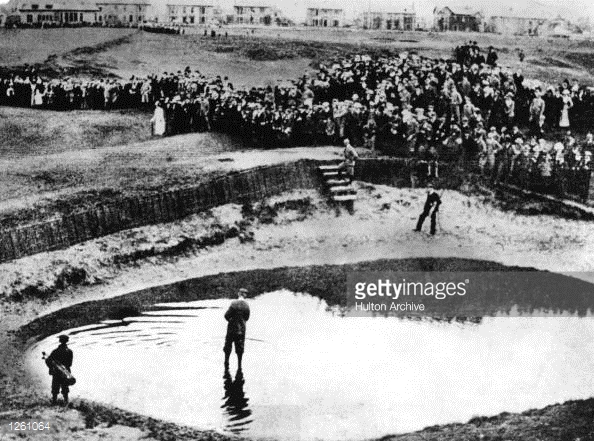
Freddie Tait ponders his approach to Prestwick’s 17th with Ball on the steps (Photo: Getty Images).
9. He competed in eight Open Championships between 1891 and 1899. He missed the 1893 Open at Prestwick. He was the leading amateur six times with his best finish being third, which he achieved in both 1896 and 1897.
10. In 1898 he made a legendary bet that he could play from Royal St. George’s G.C. in Sandwich, Kent to the neighbouring Royal Cinque Ports G.C. 3.2 miles (5,652 yards) away in less than 40 teed strokes with the same ball. The two courses do not abut so some rough scrubland between the two also had to be overcome. It was agreed that when his ball struck the Cinque Ports clubhouse the cross-country shot count would end. With a gallery, some ball spotters and his dog ‘Nails’ helping him Tait achieved the feat in just 32 shots. Unfortunately his final shot went through a clubhouse window and as a result much of his winnings were paid over in compensation to the Club. Unusually he chose not to record the challenge in his diary but it was recorded for posterity in the R&A’s Golfer’s Handbook for many years.
11. Tait was well known for celebrating his golfing victories by playing his bagpipes loudly and marching up and down clubhouses and town centres across the country. It was his friendliness and mischievous nature that the people of Scotland came to love.
12. His last competitive golf match took place at Royal Lytham & St. Anne’s G.C. on 2nd October 1899. It was a 36-hole re-match against Johnny Ball, a member of Lytham. With 5 holes to play Ball was 3-Up but Tait fought back and finally won on the 18th. Just three weeks later his life would be turned on it’s head and he would off to war.
13. In October 1899 the Second Boer war broke out and on the 22nd, as a Lieutenant in the Black Watch, Tait travelled to Cape Town in South Africa to fight. He was shot in the thigh of his left leg at the Battle of Magersfontein on 11th December. After recovering he returned to the front line in January to lead his platoon in the Battle of Koodoosburg Drift near Kimberley. On 7th February 1900 he was shot dead leading a charge.
14. He and his fallen colleagues were ‘buried in a soldiers grave’ on the banks of the Riet River. In 1963 he was re-interred in the West End Cemetery in Kimberley by the War Graves Board. A plain marble cross simply records his name, and dates of birth and death. A memorial service was held for Tait at the Church of St. John The Evangelist on Princes Street, Edinburgh on 21st February 1900. There is also a commemorative headstone in the church’s graveyard.
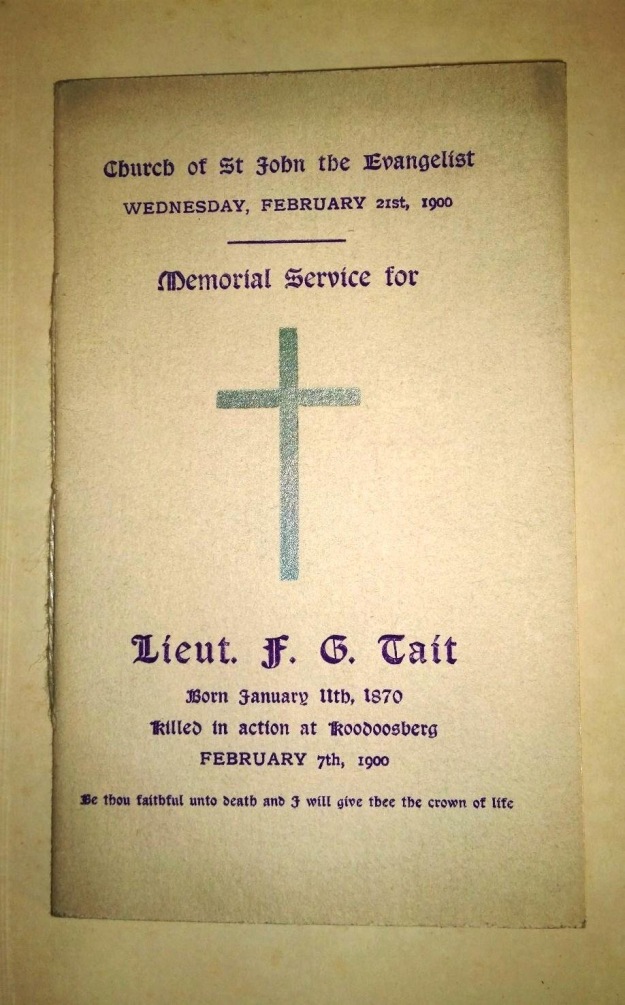
Freddie Tait Memorial Service Programme
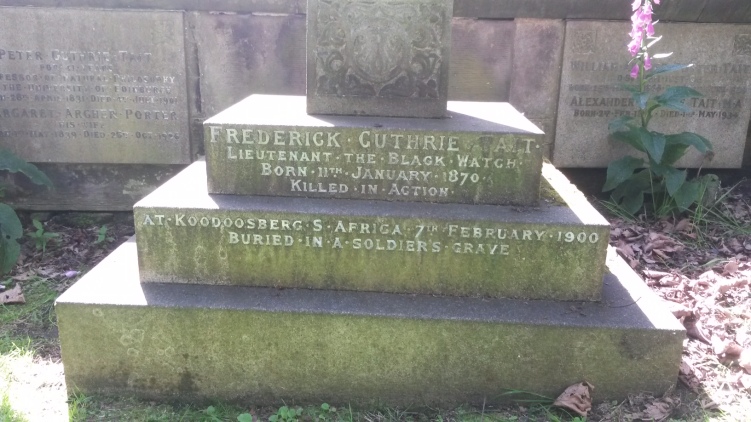
Freddie Tait Commemorative Headstone in the Church of St. John’s Episcopal Church in Edinburgh
15. There was a national outpouring of grief when the news of Tait’s death was received back home. Another amateur golfer of the day John L. Low was asked to put together a remembrance book. ‘F.G. Tait – A Record; Being his Life, Letters and Golfing Diary’ was published in 1900. With the full cooperation of Tait’s family and everyone who knew him it was the first golf biography ever written and without question one of the most comprehensive. All of the profits from the sale of the book were donated to the Black Watch Widows’ and Orphans’ Fund.
16. Given his status in the game and in particular at St. Andrews his fellow Royal & Ancient G.C. members commissioned John Henry Larimer, the famous Scottish artist, to paint his portrait in 1901. It still hangs in the R&A clubhouse to this day. The 16th hole of the Jubilee Course at St. Andrews is also named ‘Freddie Tait’ after him.

Freddie Tait with his terrier dog ‘Nails’ and a Boy Caddie (Photo: R&A)
17. The St. Andrews Memorial Hospital in Abbey Walk, opened in 1902 and closed in 2009, was largely funded by monies raised in memory of Freddie Tait.
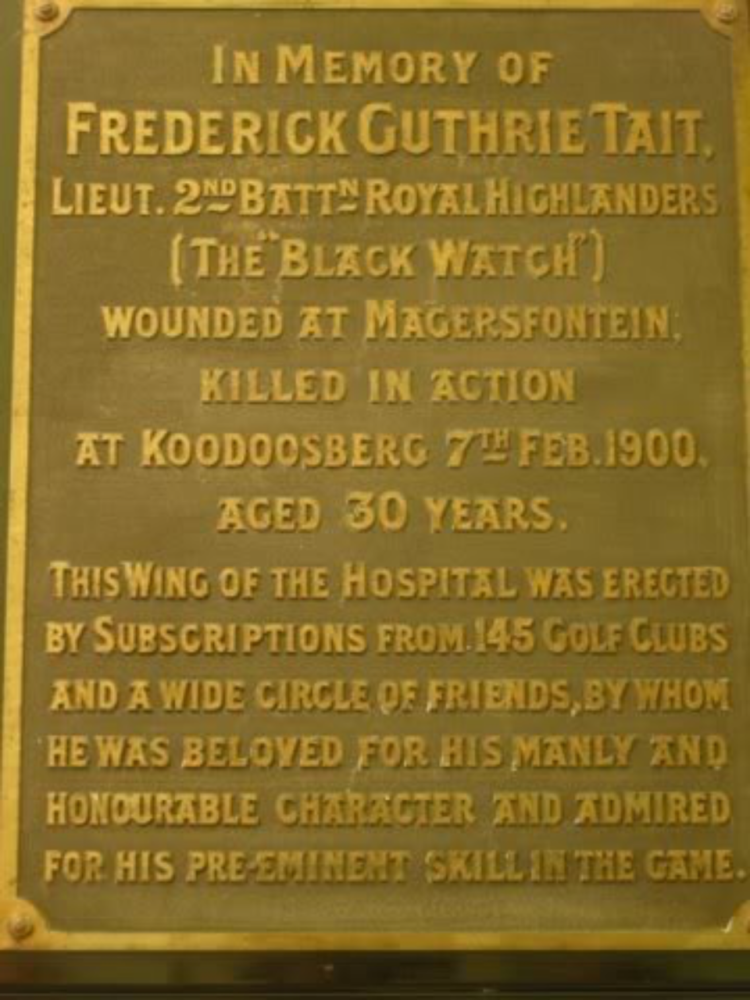
The St. Andrews Memorial Hospital Freddie Tait Wing Plaque
18. Tait was a founding member in 1894 of Luffness New G.C. in East Lothian. For many years his family allowed Luffness to display most of Freddie’s medals and other memorabilia in their clubhouse. The family tried to sell 36 of his medals in May 2009 but with an estimate of £120-180,000 they failed to sell at Convery Auctions. The National Library of Scotland acquired six Tait letters for £10,000 in the same auction. The medals were returned to their Luffness cabinet and remain there. The Club has an annual Freddie Tait foursomes stableford competition to start their season. The winners are allowed to wear some of the medals during a prize giving lunch afterwards.
19. In 1936 Lieutenant Tait’s putter was presented to the Kimberley Golf Club by J.H. Taylor who was touring with a group of UK professionals. Tait’s will had asked for his putter to be given to the club closest to the site of his death. Since 1937 the club has held an annual Freddie Tait Putter competition. In 1990, on the 90th anniversary of his death, The FG Tait Golf Museum was opened and then on the centenary in 2000 a Freddie Tait Golf Week was instigated.
20. In 1928 The Freddie Tait Cup was donated to the South African Golf Association by a touring British Amateur team who found themselves with surplus funds. From 1929 it has been awarded to the leading amateur at the South African Open, subject to them making the cut. South African greats Bobby Locke, Denis Hutchison, Dale Hayes, Ernie Els and Trevor Immelmann have all won it in the past.

Cameron Moralee with The Freddie Tait Cup in 2016 (Photo: Sunshine Tour)
Freddie Tait was a genuine national hero and a household name. Bernard Darwin, reflecting in 1933 said “I do not think I have ever seen any other golfer so adored by the crowd – no, not Harry Vardon or Bobby Jones in their primes.” He was clearly a superb golfer and a fans favourite. One can only wonder at what he may have achieved in the game if his life hadn’t been so cruelly ended by a shot through the heart when he was just 30 years old.
ME.
Copyright © 2014-2023, Mark Eley. All rights reserved.
Congratulations Mark, another excellent and fascinating post! Peter
>
Thanks for taking the time to read it Peter.
Fascinated by golf history. This article was wonderful.
Thanks Andy. Whilst tragic the Tait story is certainly an interesting one.